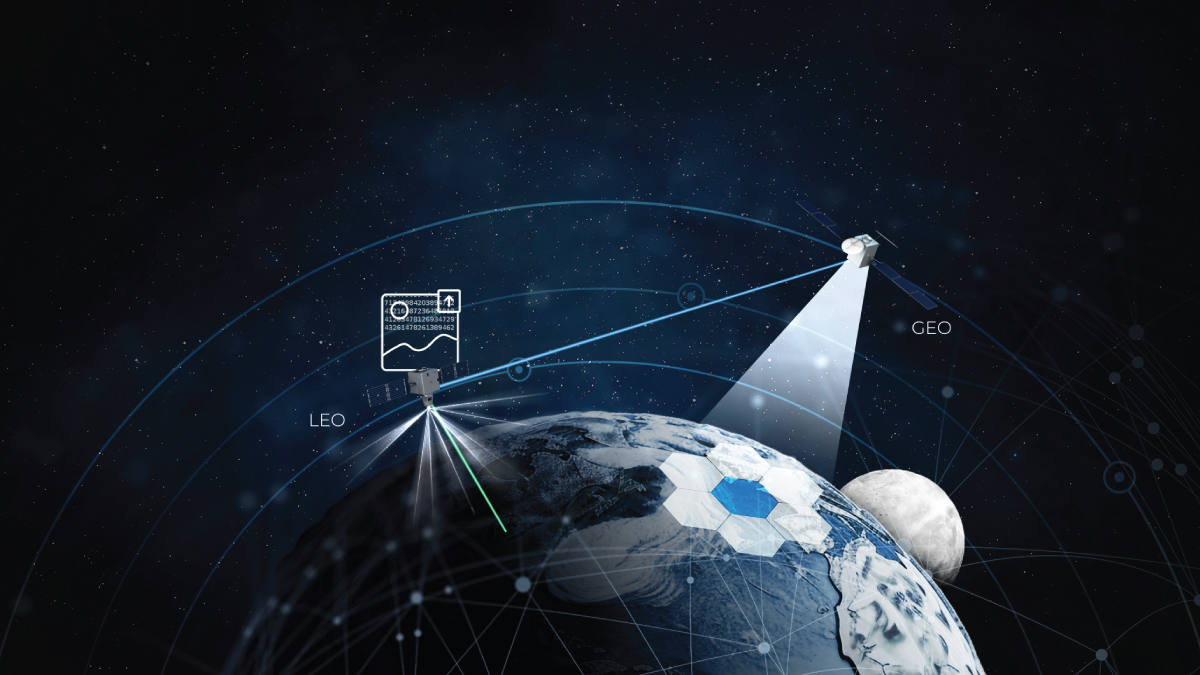 Illustration of a LEO and GEO network / distributed computing (Source: ReOrbit)
Illustration of a LEO and GEO network / distributed computing (Source: ReOrbit)
One of the largest trends in the telecom industry involves the adoption of autonomous networks - networks that leverage advanced artificial intelligence and machine learning (AI/ML) solutions to troubleshoot and automate the restoration of networks while maintaining service to customers. These revolutionary technologies would deliver network resiliency that make customer outages a thing of the past, rapidly and efficiently identifying and addressing network challenges and failures.
The ability to deliver assured uptime and much more resilient networks is equally alluring to the satcom industry, which is currently exploring these same techniques and technologies for employment in satellite constellations and their networks to provide uninterrupted connectivity, communications and data processing services to the network users. But increasing the autonomy of networks in the satellite industry could face many more obstacles than in the telecom industry.
“The telecom industry relies on fixed stations, including fixed satellites in GEO, and broadly accepted industry standards - greatly simplifying the problem compared to dynamic satellites in space,” said Guy de Carufel, CEO and Founder of Cognitive Space. “Stovepiped and custom systems are relied on for each satellite constellation with different protocols, terminal specifications, satellite capabilities and requirements, making cross-network automation challenging.”
de Carufel explained there are also significant operational constraints that make it challenging, such as cross-country geopolitical link restrictions, the harsh space environment and an increasingly contested space domain. Another challenge he pointed to is the number of possible paths in satellite networks that are significantly limited compared to ground networks. “Standardization and automation in dynamic systems and self-healing approaches specific to satellite systems will be required to reach the level of reliability found in telecom,” he said.
Once these challenges are solved, autonomous technologies are poised to completely transform how satellite networks operate and how services are provided to satcom customers.
The Benefits of Autonomous Satellite Networks
The satellite industry sees great potential in leveraging AI/ML for satellite networks to be “smart” and autonomous. “AI/ML will play a key role to improve reliability in satellite networks, especially as networks remain a key bottleneck in satellite operations,” said de Carufel. “ML can enable a data driven approach to dynamically learn best decisions for route planning, self-healing and prioritization of networks.”
Sethu Saveda Suvanam, CEO and Founder of ReOrbit, also views AI as the future of satellite networks, capable of handling large volumes of data and responding to unforeseen scenarios, as well as several other key benefits. “This includes reduced operator workload, enhanced decision-making, faster problem identification, proactive maintenance, reduced connectivity reliance and improved reactivity and recovery,” said Suvanam.
The satcom industry has already identified potential use cases that can be improved by AI/ML and autonomous capabilities. “Currently, special attention is paid to the integration of AI/ML techniques to enhance orbit determination and facilitate satellite autonomy,” said Suvanam. “By analyzing historical orbit data and potential environmental factors, AI algorithms enable predictive modeling of orbital dynamics, improving accuracy and permitting proactive maneuvering within the satellite’s operational framework. This aims to empower satellites with autonomous decision-making capabilities, enabling them to adapt to dynamic space environments.”
According to de Carufel, autonomous networks are needed more now than ever. “With the emergence of mesh networks in space through inter-satellite links, real-time communications will soon be possible for both uplinking new schedules and downlinking more data, also making automation in communications planning ever more critical,” he said. “De-confliction of pass scheduling remains a challenge, presenting an opportunity for automation to reduce downtime and increase efficiency in networks.”
Like Suvanam, de Carufel also sees valuable opportunities for autonomous satellite networks and points to important steps that have already been taken. However, challenges remain to fully leverage the capability. “Autonomous networks can reduce downtime and optimize resource allocation across available networks – assuming they’re compatible,” he explained. “Inter-constellation automation has already been deployed by satcom operators, but cross-constellation and cross-ground network orchestration is lacking.”
AI/ML Strikes Resource Allocation Balance
One critical opportunity that Suvanam sees in autonomy and AI within satellite networks pertains to balancing satellites’ data processing and connectivity needs.
Currently, functional distribution is driving more capabilities into orbit, while third-party data collection is expanding system awareness, he explained. “However, the volume of data to be processed simultaneously can quickly overwhelm traditional algorithms,” he said. “Distributed computing complements AI by maintaining the functional capabilities of the entire infrastructure, ensuring scalability, resilience and energy efficiency across each subsystem. This distributed approach allows networks to be managed as cohesive systems rather than as collections of independent satellites.”
“Consider a future multi-mission network that provides both connectivity services and carries observation sensors,” Suvanam posed. “These satellites would need to handle both communication and data processing tasks simultaneously. At the system level, the entire network must balance these tasks, but at the subsystem level, no single satellite can manage all available bandwidth for user connectivity while simultaneously processing sensor data, such as compressing images.”
Suvanam explained that AI would enable networks to adapt in real-time, redistributing processing and communication tasks among satellites based on their local conditions and the demands of end users.
“This dynamic reallocation of resources—especially in high-demand scenarios—cannot be efficiently handled by human operators or conventional algorithms,” he explained. “AI is the only tool capable of managing such complexities seamlessly. Distributed computing, in turn, ensures the system’s overall performance by shifting local congestion to a more global system level, maximizing the network’s capabilities.”
Explore More:
That Computes! Edge Computing Reshapes Space Possibilities
Podcast: Satellite Industry Softwarization, On-Board AI and Flying Routers in Space
Satellite Connectivity Providing a ‘Bridge’ to Fully Autonomous Vehicles
